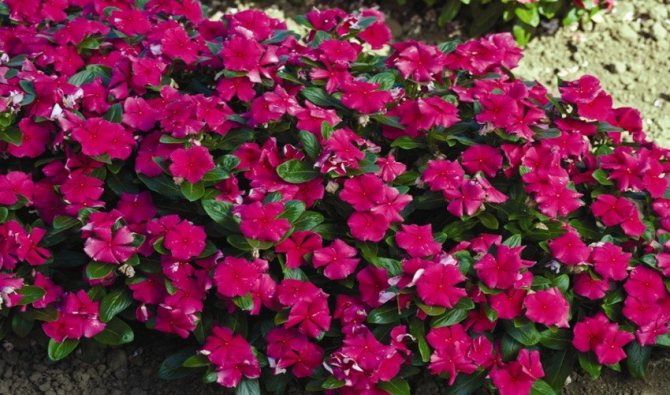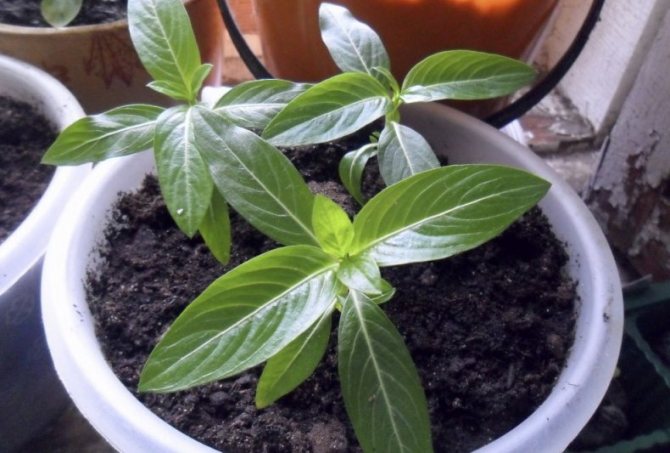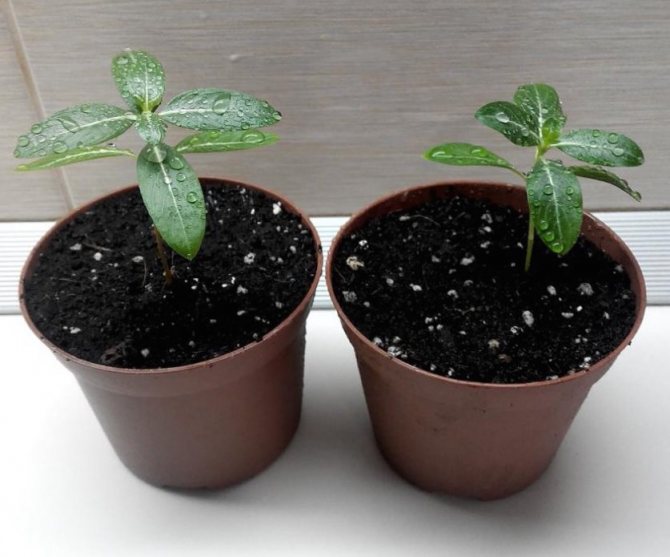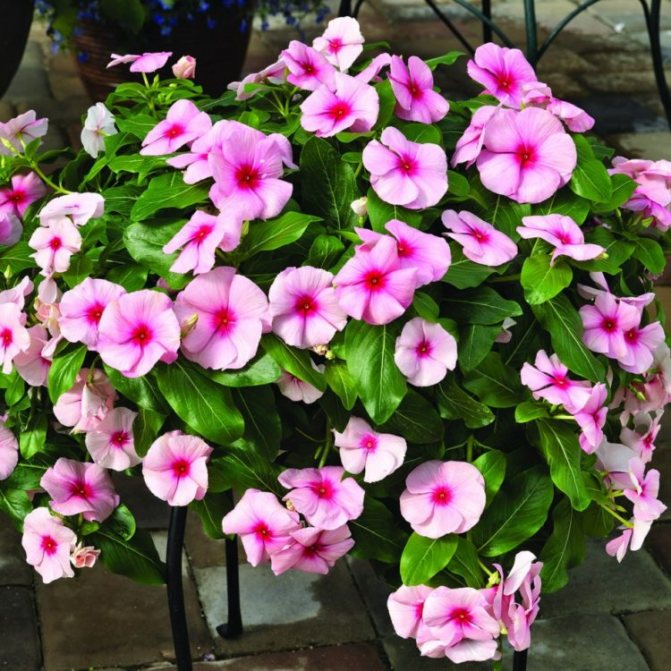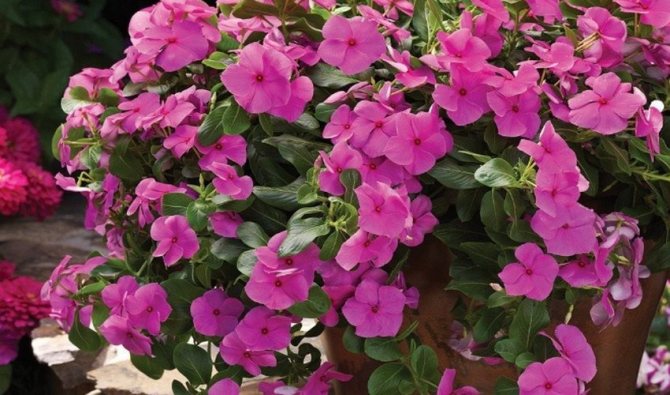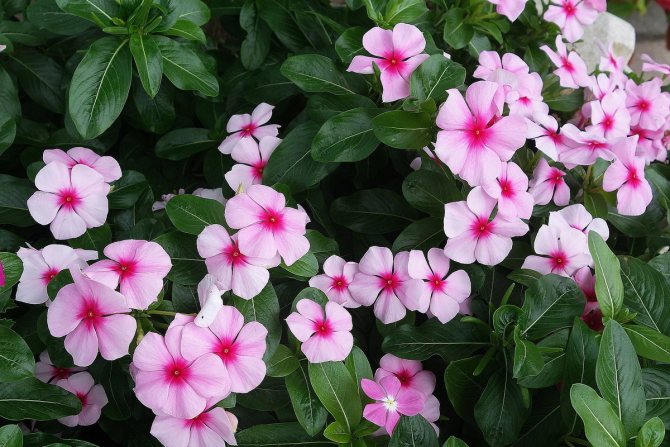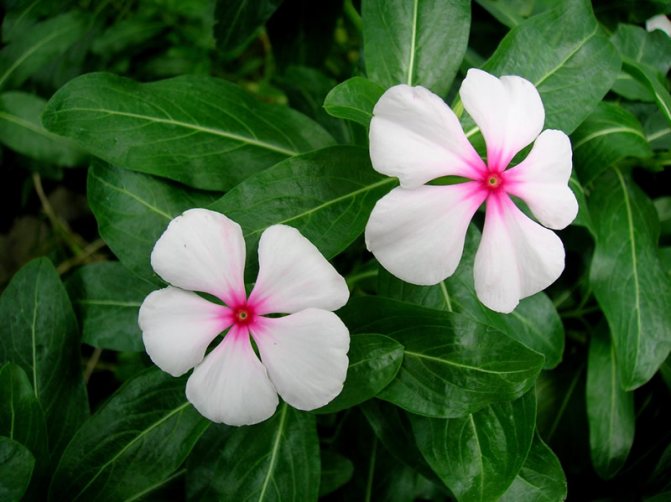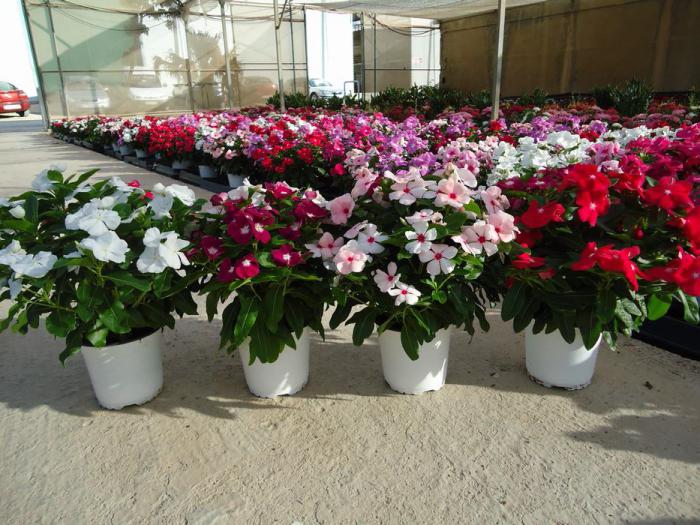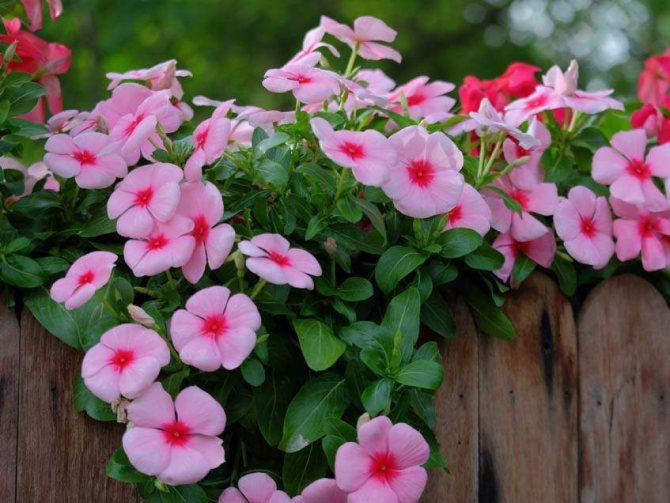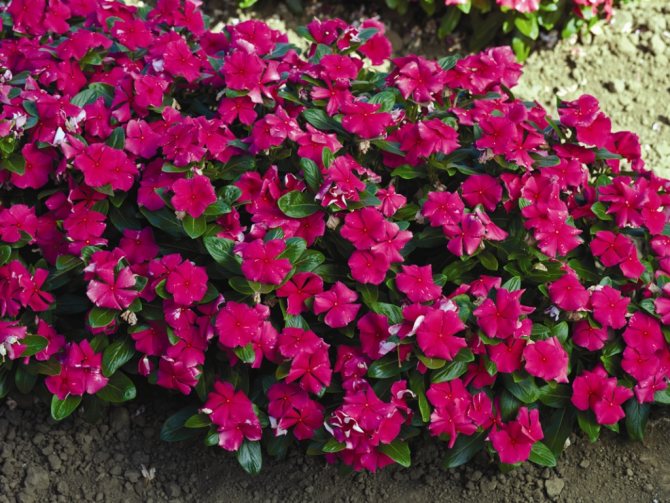Home »Flowers and plants
Flowers and Plants
Vladimir Serchenko
1 comment

Catharanthus flowers fascinate with bright colors. This resident of the tropics, although it requires increased attention, pays for it in full with its beauty. Blooming bush - cheers up. If you follow the rules, it will not be difficult to grow a catharanthus at home. Their and some other secrets of an exotic guest will be revealed in the article.
- General information
- Views
- Ampelny, cascade, mediterranean
- Aristocrat
- Pacific
- Pacific burgundy
- Pacific epricot
- Pacific white
- First kiss
- Features of growing indoors
- Shine
- Temperature regime
- Watering and humidity
- Top dressing
- Soil selection
- Pot selection
- Pruning
- Transfer
- Reproduction
- Growing seedlings from seeds
- Sowing
- Seedling care
- Rooting cuttings
- Dividing the bush
- Features of growing in the open field
- Watering
- Fertilizer
- Pruning
- Winter care
- Diseases and pests
- Healing properties
- Decoction recipe
- Tincture
- Harm
- The magic of the catharanthus
- Katarantus in landscape design
See also: How to create beautiful flower beds and flower beds in the country with your own hands? (220 fresh photos and video ideas) + Reviews
Planting and caring for the catharanthus
- Bloom: at home almost all year round, in the garden - from June to October.
- Landing: sowing seeds for seedlings - at the end of February or at the beginning of March. Planting seedlings in open ground - in late spring or early summer.
- Lighting: bright sunlight, diffused light or light partial shade.
- The soil: fertile, loose, moderately moist, moisture permeable, with a pH of 5.6-5.8.
- Watering: regular and sufficient: the soil should be slightly damp at all times, however, in cool rainy weather, the plant in the garden should be protected with a film awning. When grown at home in the heat, it is recommended to spray the leaves of the plant in the evening with cold water.
- Top dressing: a week after planting the seedlings, a solution of wood ash or complex mineral fertilizer is introduced into the soil. Further feeding is done once every 2-3 weeks. Solutions should be of moderate concentration. In the summer, the catharanthus is treated with solutions of trace elements over the leaves.
- Transfer: home catharanthus at a young age are transplanted annually, mature ones - once every 2-3 years.
- Cropping: The shoots of the domestic catharanthus, which are strongly stretched over the winter, are cut in the spring.
- Reproduction: seeds, cuttings, dividing the bush.
- Pests: aphids, mealybugs.
- Diseases: fungal and bacterial infections.
Read more about growing catharanthus below.
Watering
Katarantus is a tropical inhabitant who loves warmth and moisture very much. But watering should be such that water does not stagnate in containers with soil if the plant is grown in flowerpots or boxes.


How to properly water a catharanthus
Lack of moisture, like overflow, negatively affects the growing season and budding of the plant. With a drought, the leaves begin to curl at the catharanthus, the flowers become small. With high soil moisture, it slows down growth, the catharanthus can shed flowers. If the soil is very dense, then the constant presence in moist soil can cause the death of the dwarf shrub.
To avoid stagnant water in flowers, you should plant them in pots or boxes with drainage through which excess moisture will be drained.
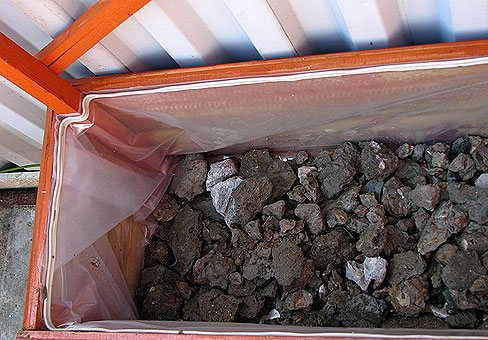

Drainage box - photo
Do not forget that the plant is very fond of moist air and spraying with warm water. It is recommended to do this procedure often, it is especially important to moisturize the leaves for those plants that are grown in the apartment.
Ampel catharanthus - description
In nature, pink catharanthus grows in Indochina, Java, Madagascar, the Philippines, Cuba and the islands of St. Mauritius. This is a tropical evergreen shrub, reaching a height of 60 cm. The root system of the catharanthus is pivotal, emitting a specific aroma. The length of the main root is 25-30 cm; numerous lateral roots of light yellow color without root hairs extend from it. The stems of the catharanthus are branched in the upper part, erect. Oblong-lanceolate, whole-edged, sessile or short-petiolate, glabrous, shiny or pubescent dark green leaves of catharanthus with a white median vein opposite. They reach 8 cm in length and 3.5 cm in width. Five-membered axillary flowers up to 3 cm in diameter with a wheel-shaped corolla are painted pink-red or white. The bark of plants with pink flowers has an anthocyanin coloration, and in white-flowered plants it is green. The fruit of the plant is a two-leafed sickle with small black seeds, but at home, pink catharanthus rarely forms seeds.
The plant catharanthus pink contains about 80 different alkaloids - from its terrestrial organs they produce drugs for leukemia. In folk medicine, diabetes was treated with catharanthus, and it was also used as an antispasmodic agent.
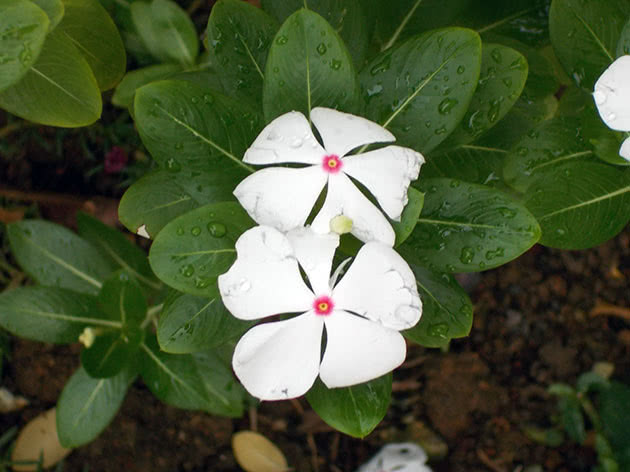

As a decorative, abundantly flowering perennial plant, ampelous catharanthus is grown in cold greenhouses and in indoor culture, and as an annual it can also grow in the garden.
- If you are late with the purchase of tulips: the late planting method
Conditions for seed germination
The container with crops is brought into a room with an air temperature of 23-25 ° C. Watering is done as needed. When shoots appear, the temperature is lowered to 20-22 ° C.
Covering material is removed every day to ventilate the container with crops. The walls of the container and the film are wiped with a dry cloth to remove moisture droplets. If this is not done, the seedlings can be affected by fungal diseases. After sprouting, the covering material is removed.
Seed germination schedule
About 2 weeks after sowing the catharanthus, the first shoots will appear. Their terrestrial part is formed slowly at first, as the root system grows. A month later, young bushes begin to actively develop.
Growing a catharanthus from seeds
Sowing catharanthus seeds
Experienced gardeners do not recommend sowing catharanthus directly into the open ground, it is safer to resort to the seedling method of growing the plant. How to sow catharanthus for seedlings? First you need to prepare the substrate - mix in equal parts turf, peat, leafy soil and humus. The soil mixture is sterilized with a dark pink solution of potassium permanganate, grooves are made in it with a depth of 1.5 cm, catharanthus seeds purchased in the store are sown, they are sealed, the surface is sprayed with water, the crops are covered with foil and placed in a warm place. The best time to sow catharanthus is late February or early March. The temperature of the content of crops is 23-25 ºC.


Catharanthus seedling care
Catharanthus from seeds can germinate in a week. As soon as the shoots appear, the film is removed from them and the crops are placed in the brightest place, but the temperature in the room must be lowered to 18-20 ºC. Caring for the catharanthus during the seedling period involves moisturizing and carefully loosening the substrate around the seedlings.Two weeks after the emergence of seedlings, the seedlings are fed with fertilizer with a predominance of phosphorus, and nitrogen in the fertilizing should be presented in a nitrate form. When the seedlings reach a height of 6-8 cm and they develop 4 true leaves, the seedlings dive. The picking of the catharanthus is carried out in separate pots if you are going to plant a plant in the garden. If the catharanthus grows at home, you can immediately dive into a pot or pots. 2-3 seedlings are planted in one container.


Selection and preparation of soil
Catharanthus prefers light, loose soil... And also the prerequisites are moisture and air permeability, because the plant does not tolerate stagnation of liquid in a pot. Ready-made seedling soil can be bought at a garden store or prepared with your own hands. If you choose the second option, then you should mix in the same proportions:
- sod land;
- deciduous land;
- peat;
- humus;
- sand.
Pre-disinfect the components. Also, don't forget about the drainage layer.
The soil before sowing seeds should be warm or at room temperature.
Peat tablets are also used as a substrate. In this case, you can do without picking the plant. Before sowing, the tablets are placed on a tray and intensively moistened.
Planting the catharanthus in open ground
When to plant a catharanthus
Planting the catharanthus in open ground is carried out in late spring or early summer, when warm, sunny weather sets in and the night return frosts pass. However, before planting seedlings in the ground, they must be hardened. For this, the seedlings of the catharanthus are daily taken out into the open air, gradually increasing the duration of the session. When the seedlings can spend the whole day in the air, they can be planted in the garden.
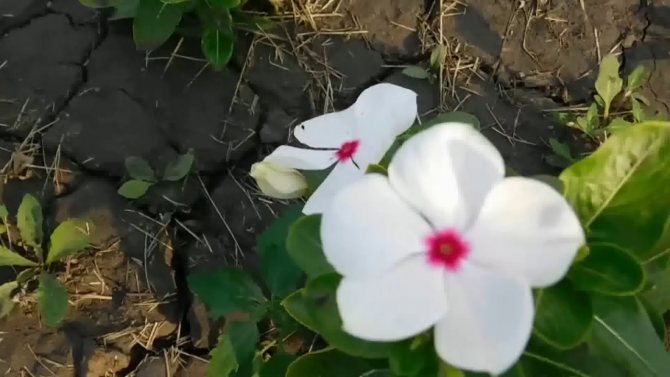

How to plant a catharanthus
Katarantus prefers open areas, protected from drafts and cold winds. The soil should be fertile, loose, moist, moisture-permeable, non-saline, with a pH of 5.6-5.8 pH. Before planting the catharanthus, dig up the garden soil in an area with peat, leaf and turf soil. But you can simply add several packages of ready-made soil mixture for digging by adding coarse sand, perlite and expanded clay. If the soil on the bed is of the desired composition, then take care of the drainage: remove the top fertile layer, place a layer of drainage mixture under it, consisting of broken brick, expanded clay, marble chips, perlite or pebbles, and then cover the drainage with a layer of fertile soil. When planting, do not place the seedlings too close to each other, keep a distance of 30-70 cm, depending on the type of plant. If you want compact bushes, pinch the seedlings once or twice.
Caring for the catharanthus in the garden
In the garden, the catharanthus is used not only as an ampel, but also as a ground cover plant. Young catharanthus in the open field need constant care. How to grow a catharanthus in the garden? Growing a catharanthus involves regular watering, weeding, loosening the soil and feeding. Weed control will have to be carried out only at first - when the cataratnus grows, there will be no room for weeds. In addition, you need to cut off the yellowed shoots in time. After that, the plant quickly recovers and gives abundant growth.


You need to water the catharanthus with water heated in the sun, and during a period of severe drought, it is sometimes useful to arrange sprinkling for the plant. Keep the soil in the catharanthus area slightly damp at all times. The fact that it is time to water the plant, you will be prompted by the folded leaves of the catharanthus, which take a normal form just half an hour after the soil is moistened.After watering, gently loosen the soil around the plants, being careful not to damage the roots close to the surface. In cool rainy weather, the catharanthus suffers greatly - both flowers and buds fall from it. To protect the plant from waterlogging, install a transparent tarpaulin over it.
- If you are late with the purchase of tulips: the late planting method
Catharanthus in the open field requires additional feeding. They begin to apply complex fertilizers or an aqueous solution of wood ash to the soil as early as a week after planting and do it regularly at intervals of two to three weeks. Catharanthus responds well to foliar feeding with a weak solution of Epin-Extra. However, when applying fertilizers, care should be taken, since the slightest excess of dosage can lead to root burns and plant death.
As you can see, planting and caring for a catharanthus in the open field is not difficult and even a novice florist can do.
Which varieties are suitable for seed growing?
Many different varieties of periwinkle are known. Most of them are interspecific hybrids. Thanks to the constant work of breeders, today there are plants on sale that look very compact, bloom profusely and are presented in different shades. There are purple, lilac, crimson, red and blue specimens. But pink catharanthus is more common than others.
Below are the most popular periwinkle varieties:
- Titanium. It is an annual ampelous plant. The length of the shoots varies from 50 to 75 centimeters. A bush grows up to 15 centimeters. The foliage is oval, dark green. The flowers are colored red. Usually Titanium is chosen for decorating loggias and balconies. Placed in pots and hanging baskets. When growing, it should be borne in mind that the ampelous Titan catharanthus is thermophilic and grows well in partial shade, in sunny places. For flowering, it is important that the soil is fertile. Seeds are sown in the month of February. The material is placed in small boxes and covered with fine-grained sand. It is necessary to maintain the temperature at +20 degrees.
- Blackberry Jam. The catharanthus Blackberry Jam looks spectacular. It is planted in gardens, grown in large pots. The plant is quite hardy, drought-resistant. Blooms in June. The culture can be placed in partial shade and in the sun. Seeds are sown at the end of winter in light, fertile, well-moistened soil. For germination, the optimum temperature is +24 degrees. Top dressing is shown.
- Pacific Regiment. The catharanthus Pacifica Polka is characterized by early and abundant flowering. The variety is unpretentious. In the southern regions, the crop is suitable for outdoor cultivation. But in the northern regions she is kept in rooms. The colors are different: apricot, snow-white, carmine red, pale pink.
- Sicily. Pink catharanthus Sicily is distinguished by lacquered leaves with crystal veins. The flowers are quite bright, similar to phlox. The bush is neat, compact and looks very elegant. In the middle lane, they are grown in apartments or greenhouses. The variety is unpretentious in care. Place it in sunny areas. Prefers fertile, well-drained soil in Sicily. When kept in a pot, transhipment is performed annually. It is important to note that periwinkle has several medicinal properties.
- Courage. It is a low bush with numerous shoots and shiny foliage of a dark green tone. The flowers are pink, dark pink and white. Their diameter is several centimeters. When growing karantus Kurazh from seeds, it must be remembered that the plant loves moderately moist, fertile, drained, loamy soil. It takes out the penumbra well. But it grows better in sunny areas. A great option for rabatki and flower beds.
Caring for the catharanthus at home
How to care for a catharanthus at home
Growing ampelous catharanthus in a room culture is no more difficult than in a garden. As in the open field, the catharanthus at home requires good lighting, but it must be protected from direct sunlight. The best place for the plant is the sills of the southern, western and eastern windows. Catharanthus, grown on northern windowsills, requires additional lighting: it needs eight to ten hour daylight hours, otherwise the development of the plant will slow down, the leaves will begin to stretch, and the flowering will stop.
The plant is very fond of daily spraying with warm water after sunset in the hot season. Both watering and top dressing should be done in the same way as when caring for a garden catharanthus, but from October, watering is gradually reduced, and fertilization is suspended until April. After watering, the excess water from the sump must be drained.
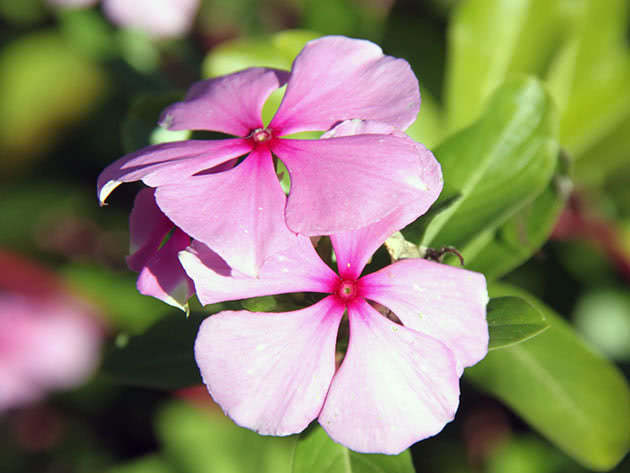

Catharanthus transplant
Only young catharanthus are transplanted annually, and mature plants are disturbed once every two or even three years. The catharanthus is taken out of the old pot and, together with the earthen lump, is transferred into a new one, filled by a third of the volume with drainage material, after which a mixture of leafy earth, peat, sand, turf and humus in equal parts is gradually added to a new pot, lightly tamping this soil mixture. Can be used for growing catharanthus and store soil for geraniums. After transplanting, the plant is watered, but fertilizers can be applied no earlier than two weeks later. Remember that all catharanthus are poisonous and take safety measures!
Pruning catharanthus
Prune the home catharanthus so that the bush is more luxuriant. The procedure is usually carried out in the spring, because during the winter the shoots of the plant are strongly stretched. For decorative purposes, you can cut the catharanthus in the summer, but be prepared for the fact that after the summer pruning, flowers will begin to appear only after 2-3 weeks.
Placement of the catharanthus
In the summer, the catharanthus feels great on the balcony, terrace, veranda, but you need to provide a shelter for it from the rain. Most often, the ampelous catharanthus is hung in pots or baskets, but you can keep it on a stand or place the pot in a container attached to the railing of the balcony or terrace. Keep in mind that the catharanthus does not like cold winds and does not thrive in drafts. If you find that the conditions on your balcony are not suitable for the plant, return it to its permanent place in the apartment, and it will gradually recover.
- If you are late with the purchase of tulips: the late planting method
Catharanthus pests and diseases
Like other plants, the catharanthus at home can be affected by harmful insects, such as aphids or worms. If you noticed pests at the very beginning of the occupation, it will be enough to wash the catharanthus with soapy water, but if you have overlooked the beginning of the lesion, you will have to resort to treating the plant with a solution of Karbofos, Aktellik or Aktara.
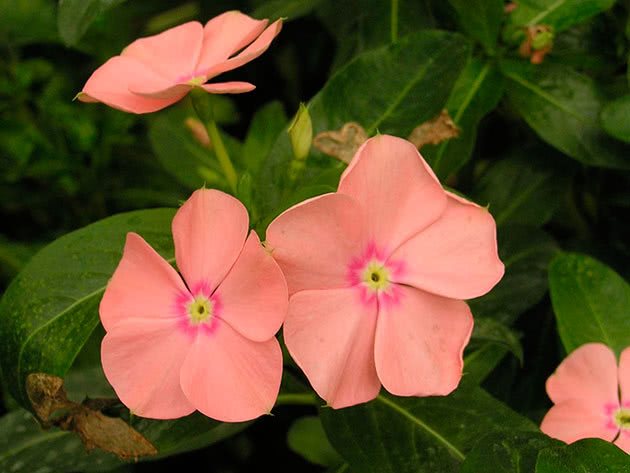

Sometimes, due to improper care, dark spots appear on the leaves of the catharanthus. This may be the result of poor lighting, lack of nutrients in the soil, planting in a soil that does not meet the requirements of the catharanthus. But sometimes stains are a sign of a bacterial disease. Find out the cause and eliminate it, and treatment with Fundazol or Maxim will protect the catharanthus from bacterial diseases.
Diseases and pests


Sick plant
If the conditions of care are not followed, the catharanthus gives signals. A symptom seen in time gives a chance to correct mistakes and save the plant.
- The leaves turned yellow and became soft - speaks of an overabundance of sunlight. The potted inhabitant must be rearranged to another place, inaccessible to the scorching rays. For a street representative, you should install protection: pull the awning.
- The tips of the leaves turned yellow - indicate a lack of moisture in the air. It is necessary to increase the spraying of the bush.At home, you can fill the pallet with wet expanded clay or moss.
- If all the leaves are normal, and the lower ones turn yellow and fall off, then this is a normal process.... Anxiety is unnecessary here.
- The reason for the small number of flowers on the bush - cold. The houseplant should be moved to a warm place. A garden flower cannot be helped. There is only one way out - to wait for warming.
- The foliage turns yellow and the flowering of the potted catharanthus has stopped - a signal that it is time to transplant. The pot became small for the plant. After changing the container to a large one, the bush will come to life, sparkle with colors.
Apart from the problems that have arisen due to improper care. The plant can be attacked by pests. It can be aphids, spider mites, felt mites, scale insects. Special means are on sale to combat them. They will quickly help get rid of the misfortune.
When moving a plant from the street to the house, you need to inspect all the leaves. If you bring pests with it. They can spread to other indoor plants.
You can fight pests using folk methods. One of these is a soap solution. You need to wipe the leaves with a soft cloth or sponge moistened with it.
back to menu ↑
See also: How to keep rose seedlings before planting? Description, classification, reproduction, pest control measures (75+ Photos & Videos) + Reviews
Reproduction of the catharanthus
In addition to the seed method of propagation of the Madagascar periwinkle, cuttings and division of the bush are also used. These methods are indispensable for the propagation of hybrid plant varieties. It is most convenient to divide the bush when transplanting - this procedure is simple, but requires caution. Parts of the divided rhizome are planted in different pots, having previously processed the cuts with crushed charcoal.
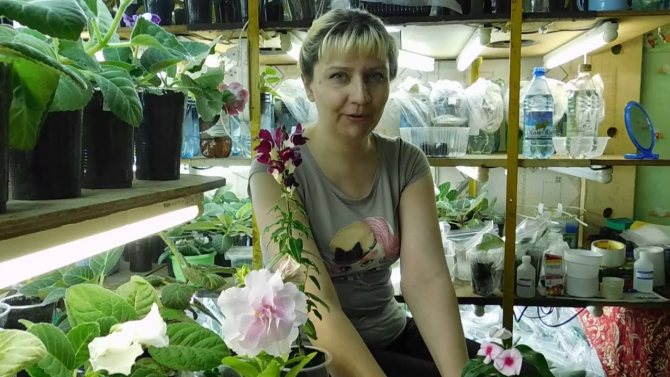

For grafting, the apical non-lignified shoots of about 15 cm long are used after pruning.They are treated at the cut points with Kornevin and planted in pots with moist soil mixed with perlite and sand, and covered with a transparent cap on top to create a greenhouse effect. Rooting of cuttings occurs in 3-4 weeks, after which they are planted in open ground or in permanent pots, pots, containers. Actually, cuttings of the catharanthus are able to take root in the sand or even in the water.
Advantages and disadvantages of the seed method
There are three ways to grow shrubs in total:
- seed;
- vegetative;
- division of rhizomes.
The simplest and most popular method is the seed method. Let's consider its advantages:
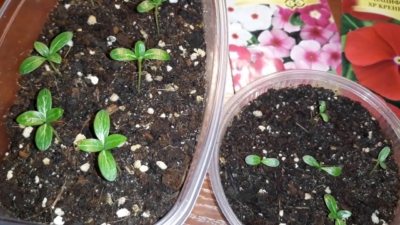

- low cost of planting material;
- seeds can be planted at any time of the year;
- short germination time;
- variety of varieties and colors of catharanthus (you can find out more information about popular species and varieties of catharanthus here);
- fast and uniform germination.
However, this method also has its drawbacks over other methods. For example:
- there is a risk of acquiring expired seeds or with poor germination;
- this growing process is very troublesome;
- you need to have a warm and sunny place for growing.
Perennial catharanthus in winter
In the open ground, the catharanthus does not hibernate, therefore, before the onset of stable cold weather - in the first half of October - it must be dug out, cut off, placed together with an earthen clod in a bucket or other large container and brought into the room. They contain catharanthus at a temperature of 15-17 ºC, moistening the earthen room as necessary. In the spring, the plant is taken out into the garden and planted in a prepared place. Trimmed apical cuttings can be used for rooting.


It is also advisable to keep the indoor catharanthus in a cool room in winter, reducing watering to a minimum and stopping feeding. For this, a glazed balcony, a loggia or an unheated veranda may be suitable.But if you do not have the opportunity to arrange the plant for a cool winter, continue to water and feed it as usual, but do not forget to spray the catharanthus daily, as the heating devices that heat your home dry up the air greatly.
How to choose seed in the store
Perennial lupine - when to plant seedlings
When choosing seeds for planting, you need to pay attention to a number of factors. If these tips are ignored, it is quite possible that the purchased seeds will turn out to be of poor quality.
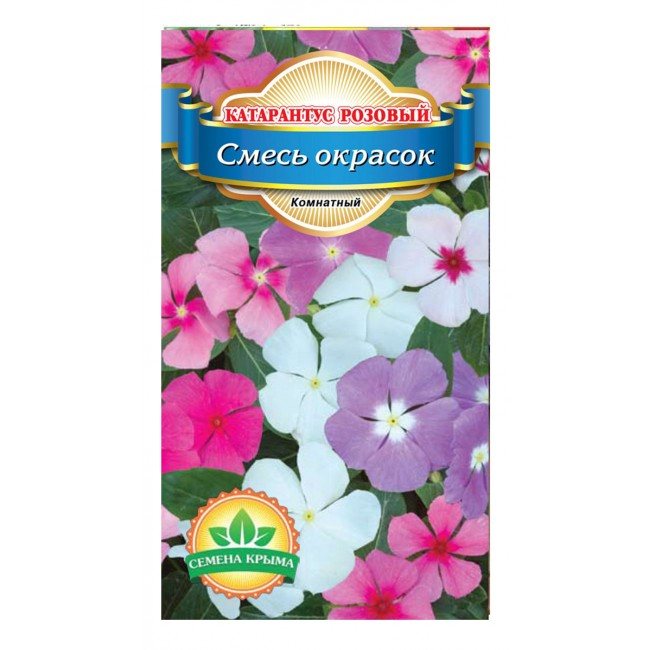

Seeds must be purchased from trusted stores
What to look for when choosing:
- The store must be verified and reputable.
- You should not buy planting material from your hands - it may turn out that they are already old and will not germinate.
- The packaging must be strong and free from defects.
- It is important to pay attention to the number of seeds in the package and the expiration date.
But even these tips don't always work. In good proven stores, there may be a defective batch.
Gardening with catharanthus
The bushes grow dense and compact, forming bright flowers, so they can be an excellent decoration for the foreground of flower beds and borders. They take care of them on balconies and terraces, they are used for landscaping apartments for home maintenance. Growing ampelous catharanthus is often carried out in pots.
It forms a green cascade pleasant to the eye, on which multi-colored buds flaunt, and also amazes with a delicate aroma. The plant is used in flower arrangements, used as a ground cover. Its neighbors can be balsam, petunia, lobelia.
Katarantus is known not only as an ornamental plant. It has been found to have medicinal properties. The juice contains about 20 alkaloids, which are used to treat benign and malignant neoplasms, adenomas and polyps. Compresses soaked in an alcoholic herb tincture are used to treat eczema, psoriasis, dermatitis of various etiologies.
So, in order for the catharanthus to please the owners with the beauty of greenery and flowers, he needs to devote time to organizing the right care.
Scheme and timing of the pick
When 4 true leaves are formed on the plants, they begin to pick. The containers are selected small, their diameter should not exceed 8-9 centimeters. The transplant is carried out carefully, since the damaged root system takes a long time to recover.
Step-by-step execution of a pick:
- the pots are filled with a loose substrate consisting of sod and leafy soil, peat, river sand, perlite;
- carefully remove the bushes from the planting box;
- planted in prepared containers;
- the ground is slightly crushed, watered with warm water.


After the appearance of the 4th leaf, the bushes are planted in small containers
Plant pots are placed in a well-lit place. If necessary, supplement with phytolamps. After 10 days, young bushes are fed.
Varieties: description and photo
Catharanthus can be found anywhere in the world. Breeders have developed a large number of different varieties of exotic shrubs. There are those that can only be grown in warm houses; special conditions must be created for them in order to enjoy a long, extraordinary and bright flowering.
Others can be grown in a flower bed, provided that they have to be planted annually from shoots or seedlings, since these types of catharanthus are annuals.
There are also perennial varieties bred for outdoor gardening. They need to be transferred to the house for the winter, because the shrubs do not tolerate the cold. The most popular variety among perennials is a cooler.
You can also get acquainted with the most popular varieties and types of catharanthus in this article.
Cooler


Grows up to 1.5 meters in height. Pleases with abundant flowering within six months. Its flowers are large, round in shape with a bright eye. In addition, the following varieties of catharanthus can be found in garden plots.
Cascade
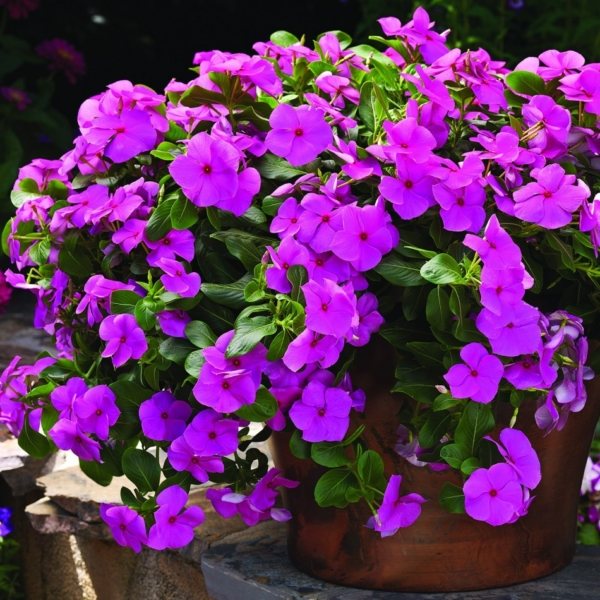

It differs from other varieties of catharanthus in that it is the only representative of ampelous plants. Flowers have a wide variety of colors. Shoots stretch over 1.5 meters in length.
Albus
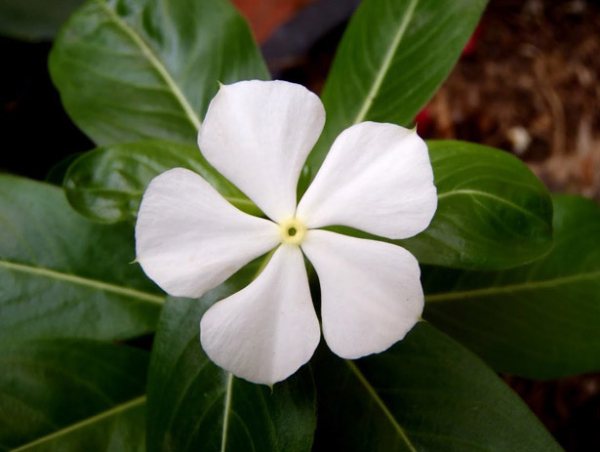

A distinctive feature of this perennial is the snow-white flowers with a yellowish center. The leaves have pointed ends and are separated by a white vein in the middle.
Grape


Perennial with purple flowers and a pink center.
Ed


The name of the shrub speaks for itself. The red color is in perfect harmony with the bright green hue of the foliage.
First kiss
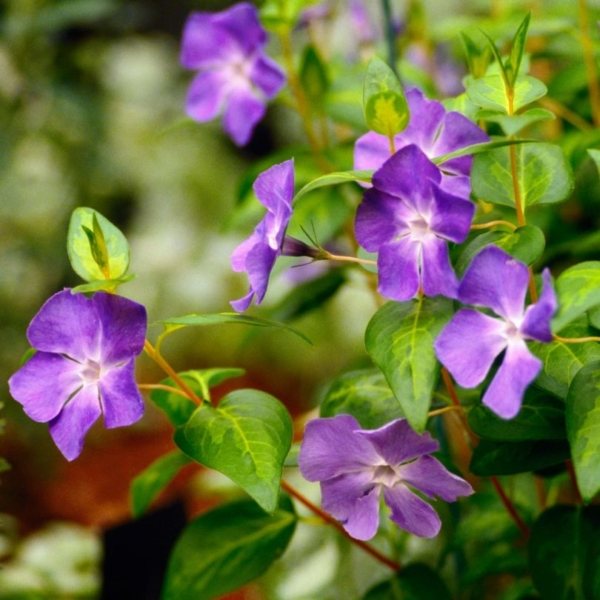

This catharanthus variety attracts attention not only with its sensual name, but also with delicate, velvety flowers of various shades. The most common color is violet-blue.




